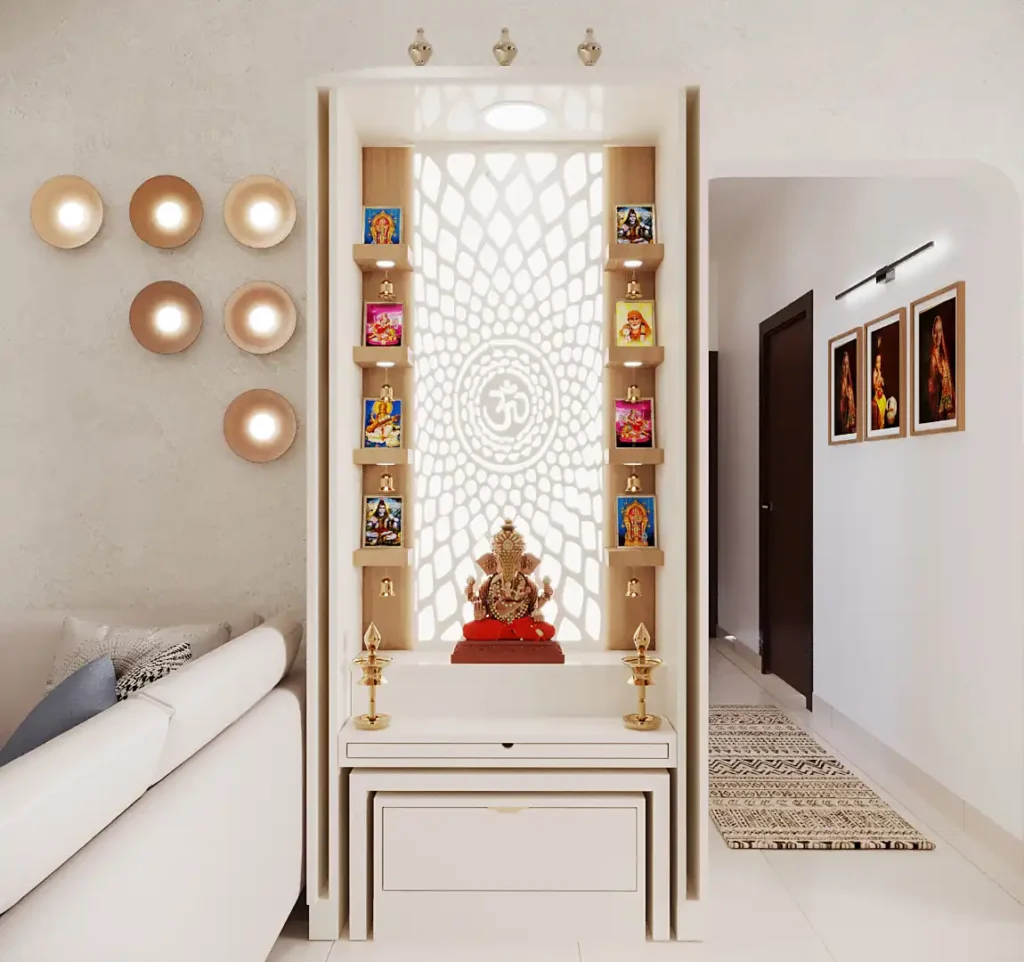Introduction
A pooja room is a sacred space in Indian homes where spiritual rituals are performed, prayers are offered, and the connection to divinity is strengthened. While pooja rooms are traditionally associated with larger homes, modern-day homes often face space constraints that make it challenging to design a dedicated space for worship. However, with the right design elements and strategic planning, it is possible to create a pooja room in even the smallest of spaces that feels open, calming, and spiritually enriching. To achieve this, many homeowners turn to interior designers in Bangalore, who specialize in creating functional yet serene spaces that enhance the spiritual atmosphere of a home, regardless of its size.
In this article, we explore various pooja room designs tailored for small spaces that not only save space but also create an atmosphere of tranquility and spaciousness.
Use of Minimalist Design for Space Efficiency
The key to designing a pooja room in a small space is adopting a minimalist approach. A clutter-free design allows the space to feel open and serene, creating a harmonious balance between functionality and spirituality. Choose simple, clean lines for furniture and decor. Avoid heavy furniture or excessive decorations, opting instead for functional yet aesthetically pleasing pieces.
When designing a minimalist pooja room, the use of neutral color tones, such as whites, creams, or light greys, can make the space feel larger and more expansive. These colors reflect light and make a small room feel more open and airy.
Additionally, keeping the pooja room’s design light and airy by incorporating glass doors or screens can open up the space and maintain privacy while avoiding the closed-off, cramped feeling. Sliding glass doors or transparent partitions also make the room feel less confined, bringing in natural light and a sense of openness.
Vertical Space Utilization
One of the most effective ways to make the most of limited space is by using vertical space. Install shelves or wall-mounted cabinets that extend upwards rather than taking up valuable floor space. These shelves can store pooja essentials such as incense holders, prayer books, and small idols.
A wall-mounted pooja platform or altar is another great option for small spaces. It creates more floor space while still allowing you to create a sacred space for prayer. You can also consider installing a floating platform, which provides a sleek, modern look and helps maintain an uncluttered environment.
Using vertical space also allows for the inclusion of decorative elements like small potted plants, LED lights, or a wooden frame to hold a photograph of deities, without cluttering the floor area. This maximizes the feeling of spaciousness in the room while retaining the essence of a pooja space.
Multi-functional Furniture
Multi-functional furniture is essential for maximizing the utility of a small space. For a pooja room, you could consider designing a platform that doubles as both an altar and storage. The top can serve as the space for prayers, while the drawers or hidden compartments can store essentials like candles, incense, or extra prayer accessories.
Another great option is foldable furniture. A foldable pooja table or a compact chair can easily be stored when not in use, freeing up the space for other activities. These space-saving options give the flexibility to transform the space based on needs, making it more versatile.
Incorporating Natural Light and Airflow
Natural light plays a significant role in making any small space feel more open. If possible, design the pooja room near a window or even use skylights to allow natural light to fill the room. Natural light brings a sense of expansiveness, as it adds warmth and helps create an inviting atmosphere.
Additionally, proper airflow is essential for small spaces to feel comfortable. Avoid heavy curtains or large, bulky furniture that can block windows and hinder the flow of air. Opt for light, breezy fabrics for curtains or go for blinds that provide privacy while still allowing fresh air and light to filter through.
If natural light is limited, consider using soft LED lighting to create an ambient, soothing atmosphere. Dim lights with a warm hue can replicate the peacefulness that natural sunlight provides, making the room feel less cramped.
Mirrors and Reflective Surfaces
Mirrors are a clever design trick to make a small room appear larger. The reflective surface of mirrors helps bounce light around the space, creating a sense of depth and openness. Consider incorporating mirrors into the pooja room design by placing them on one or more walls.
In addition to mirrors, reflective materials such as glass or polished metal can also be incorporated into the design of the pooja room. For example, a glass pooja platform or a decorative brass metal screen can amplify the feeling of spaciousness while adding elegance to the design.
Strategic Layout and Flow
The layout of your pooja room plays an essential role in making the space feel open and organized. Focus on creating an organized flow in the room, ensuring that essential elements are placed in a way that makes it easy to move around and perform rituals.
The pooja altar or platform should be the focal point, and everything else should be arranged symmetrically around it. If possible, avoid placing furniture or other elements in front of the altar to maintain a clear line of sight and to enhance the spiritual connection.
The design layout should also incorporate space for seating or a place to sit during prayers. A small bench or a couple of floor cushions can work well and add comfort without overcrowding the space.
Incorporating Nature into the Design
Bringing nature into your pooja room design can significantly enhance the sense of spaciousness and tranquility. Incorporate indoor plants or small potted plants in and around the pooja space. Plants like jasmine, basil (tulsi), and peace lilies not only add to the aesthetic but also improve air quality, creating a serene and peaceful atmosphere for prayer and meditation.
You can also consider incorporating water elements like a small tabletop fountain. The sound of flowing water adds to the tranquility of the space, enhancing the overall feeling of calmness and spaciousness.
Neutral and Light Materials
Using light, natural materials for furniture and flooring is another way to make a small pooja room feel more expansive. Materials like light wood, bamboo, or marble can be used for the altar, shelves, and flooring. These materials add a sense of calm and serenity to the space and reflect light, making the room feel more spacious.
When selecting furniture and fixtures, opt for designs that incorporate natural materials and colors, as these elements create a sense of warmth and openness.
Professional Assistance from an Interior Designer in Bangalore
For those looking to achieve the perfect pooja room design for their small space, consulting an interior designer in Bangalore is a smart choice. An experienced interior designer can provide personalized solutions and designs that maximize space while maintaining the spiritual and aesthetic elements of a pooja room. They will ensure that the design aligns with your specific requirements, from the pooja room layout to the selection of materials, ensuring functionality and beauty in a small space.Top interior designers in Bangalore offer expertise in space optimization, helping you create a pooja room that enhances your spiritual practices while making the most of every square foot.
conclusion
Designing a pooja room in a small space requires creativity, planning, and attention to detail. With the right design elements, it is possible to create a serene, spacious, and inviting pooja room, no matter the size of your home. Whether you opt for minimalist furniture, use vertical space, or incorporate natural light and plants, these design tips can help you achieve a peaceful, expansive pooja room that enhances both the aesthetic and spiritual quality of your home.



